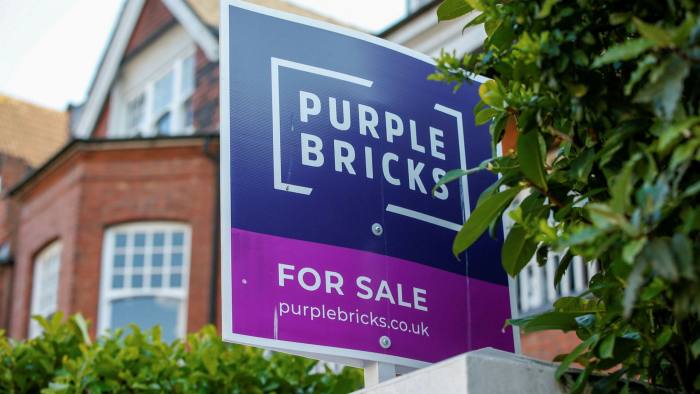What’s next for Purplebricks?
Purplebricks has a new CEO Helena Marston, following the rapid departure of Vic Darvey. But what strategy will she use to get that 21.5p AIM share price ticking upward?
Parking up the likely class action that is about to engulf the company regarding whether LPEs were in or outside of the company, plus the cost of the lettings debacle, what’s next for Purplebricks?
To help see the future for this behemoth, it’s time to look backwards.
Purplebricks has been around in some form or another for a decade. In its genesis in 2012, it traded under the name New Portal Limited, then it became New Broom Limited, and now it’s Purplebricks.
So, the original DNA of the company was digital efficiency and, judging by the name, obviously a portal play that sought to do agency more efficiently, and this was way before proptech exploded with 60% of SMEs chasing the digital dream and setting up by 2016 in the UK.
It’s interesting now that two of the major architects of Purplebricks, Michael Bruce and Kenny Bruce, the latter of which exited then went on to create Boomin, formulated a portal/platform concept to ‘do property’ in a modern way, with client and agent UX at the core.

Looking at what Purplebricks has accomplished, here are my thoughts.
Unlike 95% of the clients I deal with in my day job, helping proptech and fintech founders grow and then get to exit with their SME, Purplebricks is actually a huge money-spinner. The problem is that though it generates lots of cash front end, its operations eat that cash just as quickly.
In terms of investment raised and cash through the business, hundreds of millions have poured into the company and straight out the other side. Yes, there was the usual call for a global crusade to capture new markets, all failing, and only the Canadian re-sale of that asset helped to give the company a marginal profit last year.
Purplebricks ‘strength’ is that it lives partly in the metaverse. Unlike the Connells Group, it does not have thousands of employees in physical offices across the nation, so no huge operational costs, no expensive premises, etc. Its weakness, living online makes you invisible in a slow-changing property mindset world, where the public still likes the goldfish bowl windows of agents dotted around their community.
The bigger weakness though is solving the original problem posited by the original team at Purplebricks. Mr Pindar may well still be the Chairman, but the market cap of the company is £66million down from £100million, and half what Boomin only a year old now has been valued at.
What is missing, and I see it a lot that is, is the business model. What is it? Originally Purplebrick’s rationale was to do agency better, using the hand tools of the modern age, cloud computing having got into top gear in 2005 and of course the internet beginning its unstoppable reach.
What Helena Marston would do well to do is look up the definition of her new company on Wikipedia, it needs some updating but the shape of it is close.
“Purplebricks is a technology-led estate agency that provides a hybrid service, as it combines the use of an online platform and local property agents. Vendors and landlords can manage their property let or sale using the online platform and app. The local property agents assist with valuations, listings, and other ancillary services. The company does not maintain a branch network of brick-and-mortar estate agencies, which reduces fixed costs associated with rent, energy usage, and other operational expenses. In part due to these savings, Purplebricks charges customers lower fixed fees.
Purplebricks charges a fixed upfront fee for its services that sellers pay to be listed, rather than a percentage of the sale price once the property sells. This fee includes consultation services from a local agent, photography of the property, listings on property portals like Rightmove and Zoopla, and management of the sales process. Payment may be made when the property is listed or after a ten month deferral. This approach is different from the commission-based structures of traditional estate agencies, in which agents are paid their fee only if the property sells.”
My thoughts are if a CEO or Chair came to me with this as an MVP or even just an idea, my first ask would be “show me the tech” – that is the win or lose part of the business. And how does your model do something unique and smart that the consumer will love as they drive revenue?
To say you are building a stripped-down, digitally-powered version of real estate that is a ‘copy’ of the old model of doing property does not make sense, it will just whirl around and burn itself out. It needs to be on a trajectory.
The property industry is playing out at a time of immense change, we are all going kicking and screaming into the digital night. A huge segment of the population is 35 years of age or younger, seeing the future very much through a digital lens with everyone running their lives via algorithms communicated through their smartphones. But Purplebricks, with its past misgovernance and failure to use all of that cash to build out a coded solution, leads to a lot more blood on the corporate carpet when the full figures for Purplebricks are unveiled sometime soon.
Purplebricks was the innovator in 2012. Yes it made mistakes, all companies do. But it wanted to reinvent. Now all it does is have a sizeable portion of non-expensive property of a certain type in certain key areas, which is why the Connells Group rule the marketplace selling across price bands and areas.
I genuinely wish Helena all the luck in the world because she and everyone else in that C-suite are going to need it.
RIGHTMOVE REPORT: Third consecutive price record & homes selling faster than ever in spring market frenzy

Source: https://www.rightmove.co.uk/news/house-price-index/
- The price of property coming to market hits a new record high for the third consecutive month, up by 1.6% (+£5,537) to £360,101
- Despite growing economic headwinds, the 2022 market continues to set new milestones for price and activity levels:
- All regions and all market sectors reach new record price highs, for only the second time since 2007
- Properties selling faster than ever, twice as quickly as in the more normal market of 2019
- Last three months’ price jump of over £19,000 is largest seen in any three-month period since records began
- 53% of properties are selling at or over the full asking price, again the highest level ever seen
- The pace of price rises this year appears to be tailing off slightly as affordability constraints and economic headwinds combine:
- High buyer demand for limited stock for sale suggests that while price growth may slow down, sustained price falls are unlikely
- Number of transactions remains steady, with sales agreed 21% higher than the more normal 2019 market
The price of property coming to market has hit a new record high for the third consecutive month. Month-on-month prices have risen by an average of 1.6% (+£5,537), and over the last three months by £19,082. This figure is the largest three-month price increase that Rightmove has ever recorded, with high buyer demand enabling sellers to ask and achieve ever higher prices. With not enough property available on the market, sellers are able to find a buyer quicker than ever previously seen by Rightmove, and twice as quickly as in the same period in the more normal market of 2019. This momentum is despite the growing economic headwinds, though we forecast that these headwinds will slow the pace of price rises as the year progresses.
Tim Bannister, Rightmove’s Director of Property Data comments: “With three new monthly price records in a row, 2022 has started with price-rise momentum even greater than during the stamp-duty-holiday-fuelled market of last year. While growing affordability constraints mean that this momentum is not sustainable for the longer term, the high demand from a large number of buyers chasing too few properties for sale has led to a spring price frenzy, a hat-trick of record price months, and the largest price increase for a three-month period Rightmove has ever recorded. The strong momentum has carried over from last year and, combined with the impetus of the spring moving season, has delivered the quickest selling market we’ve ever seen. The high speed of the market and competition among buyers when making an onward move will be deterring some owners from putting their homes up for sale. However, if you can secure both a quick sale and a quick purchase then it’s a lot less stressful than the uncertainties of a slower market when finding a buyer for your own home can drag on for months or not happen at all. Over 125,000 new sellers have taken advantage of the great sellers’ market this month, but more are needed in all areas and in all property sectors to meet high buyer demand.”
Across Great Britain, and in all of Rightmove’s lower, middle, and upper market sectors, properties are at new record price levels. This is only the second time since 2007 that Rightmove has measured such an event, with the previous ‘full house’ being earlier in this property frenzy in October of last year. The frenetic activity continues, with this month seeing properties selling faster than ever previously recorded by Rightmove. This time in 2019, the average time to sell was 67 days. It now stands at an average of just 33 days before a property is marked as sold subject to contract on Rightmove. Of course, this is an average, and some popular properties are sold within days while others that are less desirable may still take months.
This fastest-ever speed of sale means that 53% of properties that sell are now selling at or over their final advertised asking price, the highest percentage we have ever measured. Overall, our analysis shows that properties are achieving 98.9% of the final advertised asking price on average, which is also the highest percentage since our records began. However, the pace of price rises does now appear to be tailing off a little, with this month’s increase of 1.6% being lower than the 1.7% and 2.3% in the previous two months. Whilst it is normal to see modest seasonal price falls in several months of the second half of the year, with stock remaining at record lows and underlying strong demand, we do not expect these falls to be any more significant than usual this year.
Bannister says: “The economic headwinds of strongly rising inflation and modestly rising interest rates are being kept at bay by the even stronger tailwind of property market momentum that has carried over from last year. 2021 saw four consecutive monthly price records from April through to July and I would not bet against that being bettered this year as we are already at three consecutive records in April. There are some early signs of an easing off from the frenetic pace of price rises, and buyer enquiries to agents are down by 16% on last year’s stamp-duty frenzy. However incredibly, buyer enquiries are still 65% above the more normal market of 2019 and the number of sales agreed is up 21%. While there is growing economic uncertainty, our current market statistics show there is greater certainty that your property will sell more quickly than ever before, and likely at a record price. It can’t and won’t continue like this, but with the demand and supply imbalance being so out of kilter, it looks like any substantial slowdown will be gradual in coming and be a soft rather than hard landing. It seems likely that the supply/demand mismatch will remain for at least the rest of this year. Even with some economic uncertainty, where you live and your home is such a fundamental decision for people that it will remain a priority for many.”
Andrew Stanton is the founder and CEO of Proptech-PR, a consultancy for Founders of Proptechs looking to grow and exit, using his influence from decades of industry experience. Separately he is a consultant to some of the biggest names in global real estate, advising on sales and acquisitions, market positioning, and operations. He is also the founder and editor of Proptech-X Proptech & Property News, where his insights, connections and detailed analysis and commentary on proptech and real estate are second to none.












